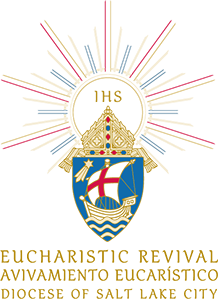Reflection: The Eucharistic Prayer Part II
(Editor’s note: This is one in a series of reflections on the importance of the Eucharist and what it means to be a Eucharistic people. These reflections are part of the Diocese of Salt Lake City’s participation in the National Eucharistic Revival, which began last June and will end in July of 2024 with the National Eucharistic Congress in Indianapolis. These reflections are designed to be read aloud at Mass by a priest, deacon or experienced minister following the Prayer after Communion. They will appear in print in this newspaper and on the diocese website, www.dioslc.org. The series of reflections will continue through June in preparation for the July 9, 2023 Diocesan Eucharistic Rally at the Mountain America Expo Center in Sandy.)
One of the simplest statements we can make about the Mass is that it is basically the community of believers coming together to relive the entirety of Salvation History, from creation to the Resurrection. Finally, we have come to the most significant moment in this reliving, because this moment, after the priest has invoked the Holy Spirit to come down upon the gifts of bread and wine, is a reliving of the Last Supper, when the Eucharist was instituted. We are actively participating in the re-presentation of the Last Supper. Just as Christ’s apostles were present, we have chosen to answer Christ’s calling and to make ourselves present at this moment. The priest begins this moment of the consecration by stating the context of the Last Supper before reciting the words of Christ given to his apostles at this moment.
The priest is not quoting the words of Christ; rather, Christ is speaking to the congregation directly and actively through the priest when he says, “This is my body, which will be given up for you.” Within this moment, two life-changing things are taking place. First, the moment of the Last Supper is now united to the moment of the crucifixion when Christ sacrifices himself for us. Just as we have chosen to be present at the Last Supper, we have now also chosen to be present at the foot of the cross, kneeling and accepting that Christ’s sacrifice is for us.
Second, because the words of Christ at the Last Supper are deeply united to the moment of his sacrifice, his words at the Last Supper become literal. He took what was once bread and wine and declared that it is literally his body, given up for us. This is the moment that the bread and wine are transubstantiated (their substances are changed in the most fundamental way) into the body, blood, soul and divinity of Jesus Christ.
This miraculous event is made possible only by simple words because these words are not merely being uttered by a priest; these words are being uttered by Christ through the priest. Still, we may ask ourselves how even Christ’s words have the power to change the substance of something today.
We must remember that Jesus Christ is God the Son, the Word made flesh. Jesus Christ is the same Word that created the heavens and the earth at the beginning of time. This Word has the power to create and transform, and it is through this Word that the work of human hands becomes the body and blood of Christ.
The priest then raises the host and the chalice in the same way the body of Christ was raised on the cross for all the world to see. This is such a solemn moment because it is the most important moment of human history being re-presented to us in the present moment.
The priest will then call us to recognize “The Mystery of Faith,” referring to the Paschal Mystery – Christ’s Passion, death and resurrection. Remember: throughout the Mass, we actively relive the entirety of Salvation History. By declaring the Mystery of our Faith to us, the priest reminds us that this moment of the Mass is us actively living the climax of Salvation History and human history – when God, who became man, opened the door to salvation for all people.
© Copyright 2025 The Diocese of Salt Lake City. All rights reserved.


Stay Connected With Us